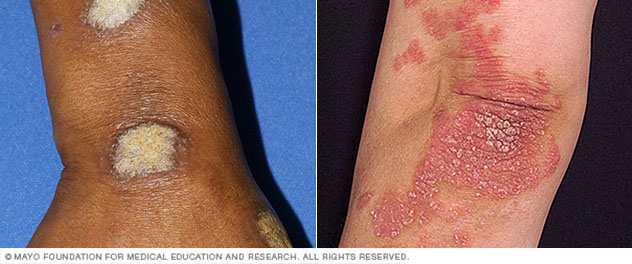Overview
Psoriatic arthritis is a type of arthritis that can affect people who have psoriasis. Psoriasis is a skin condition that causes itchy, scaly patches on the skin. The patches may be red, purple or brown depending on your skin color. Most people get psoriasis first, sometimes years before symptoms of psoriatic arthritis start.
The main symptoms of psoriatic arthritis are joint pain, stiffness and swelling. These symptoms can affect any joint in the body. The symptoms of this condition can vary from mild to serious. Like psoriasis, psoriatic arthritis often goes through cycles. Sometimes symptoms flare up. Other times, they may ease or go away for a while.
There's no cure for psoriatic arthritis. But treatment can help lessen symptoms, protect the joints from damage, and improve your ability to move and stay active.

Psoriasis
Psoriasis causes cells to build up rapidly on the surface of the skin, forming thick, silvery scales and itchy, dry patches that may be painful.
Symptoms
Psoriatic arthritis and psoriasis are long-term conditions that can get worse over time. But symptoms also can come and go. You may have flare-ups where symptoms get worse. And you may have periods of relief when symptoms improve or go away for a while.
Psoriatic arthritis can affect joints on one or both sides of your body. Psoriatic arthritis shares some symptoms with rheumatoid arthritis. In both conditions, joints may feel painful, swollen and warm to the touch.
Psoriatic arthritis also may cause:
- Swollen fingers and toes. Fingers and toes may become swollen and puffy, sometimes looking like sausages.
- Foot pain. You may feel pain where tendons or ligaments attach to bones. This condition is especially common at the back of the heel, called Achilles tendinitis, or in the sole of the foot, called plantar fasciitis.
- Lower back pain. Some people develop a condition called spondylitis, which causes pain and stiffness in the spine and pelvis.
- Changes in nails. Fingernails or toenails may develop tiny dents, called pits. The nails may become brittle or crumbly, and they may start to lift away from the skin underneath. These changes can look like a fungal nail infection, so it's important to have your care team check to be sure of the cause.
- Eye inflammation. A condition called uveitis can cause red, painful eyes and blurry vision. If not diagnosed and treated, it can lead to vision loss.
- Fatigue. Many people with psoriatic arthritis get very tired.
When to see a doctor
If you have psoriasis and start to notice joint pain or stiffness, tell your healthcare professional. Talk to your healthcare professional about seeing a rheumatologist. A rheumatologist is a doctor who specializes in treating psoriasis and psoriatic arthritis. Treating psoriatic arthritis early can help prevent lasting joint damage.
From Mayo Clinic to your inbox
Causes
Psoriatic arthritis happens when the immune system attacks healthy joints and skin by mistake. The immune system is the part of the body that fights illness, but in psoriatic arthritis it attacks healthy tissue. This causes swelling in the joints and makes the body make too many skin cells.
Researchers aren't exactly sure what causes psoriatic arthritis. But it seems to be linked to both your genes and things in the environment. Many people with psoriatic arthritis have family members with the condition or with psoriasis.
Certain genes may make someone more likely to get the condition, including a gene that makes a protein called HLA-B27. This protein is found on the surface of some white blood cells. It plays a role in how the immune system works. HLA is short for human leukocyte antigen. Testing to see if a person has HLA-B27 is called HLA typing. Not everyone with this gene will develop psoriatic arthritis, and not everyone with the disease has the gene.
For some people, things in the environment — such as an injury, a virus or a bacterial infection — may trigger psoriatic arthritis if they already have the genetic risk.
Risk factors
Some things make it more likely that you will develop psoriatic arthritis, including:
- Psoriasis. Having psoriasis is the biggest risk factor. Most people who get psoriatic arthritis already have this skin condition.
- Family history. If a parent or sibling has psoriatic arthritis, you have a higher chance of getting it too.
- Age. Psoriatic arthritis can happen at any age, but it typically starts between ages 30 and 55.

Psoriasis on the nails
In some people, psoriatic arthritis can cause pitted nails that are thickened and discolored. Nails may separate from the nail bed. Sometimes this can be confused with a fungal infection of the nails.
Complications
In rare cases, psoriatic arthritis can lead to a serious condition called arthritis mutilans. This form of the disease causes severe pain and damage to the small bones in the hands, especially the fingers. Over time, it can change the shape of the fingers and make it hard to use the hands for everyday tasks.
Psoriatic arthritis also can be associated with other conditions including:
- High blood pressure, called hypertension.
- Metabolic syndrome, which is a group of conditions that raise the risk of heart disease.
- Diabetes.
- Heart disease.
- Gout.
- Anxiety and depression.